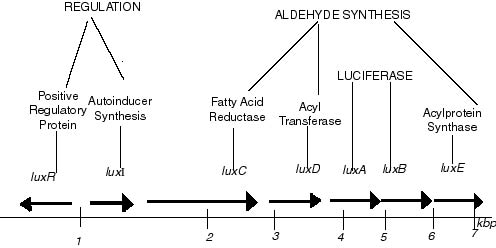Team:Cambridge/References/ProjectBioluminescence/Luciferase
From 2010.igem.org
(Difference between revisions)
(→Other Insect luciferases) |
m (formatting) |
||
| Line 1: | Line 1: | ||
| - | {{:Team:Cambridge/Templates/ | + | {{:Team:Cambridge/Templates/headerMinimalprototype}} |
| - | + | <html> | |
| + | <div style="width:730px; background:#96d446;" class="secheader">Luciferase</div> | ||
| - | = | + | <div style="padding-left:10px; text-align:justify; background:#f8f8f8; color:#333333; width:720px; padding-left:10px; padding-top:5px; padding-right:10px; margin-top:5px;"> |
| + | </html> | ||
==Mutant luciferase (P. pyralis)== | ==Mutant luciferase (P. pyralis)== | ||
| Line 54: | Line 56: | ||
613 nm http://www.promega.com/pnotes/85/10904_11/10904_11.pdf <html><img src="http://www4a.wolframalpha.com/Calculate/MSP/MSP52619bedhd64d9hi9240000123ei80gh721227b?MSPStoreType=image/gif&s=40&w=99&h=20"></html> | 613 nm http://www.promega.com/pnotes/85/10904_11/10904_11.pdf <html><img src="http://www4a.wolframalpha.com/Calculate/MSP/MSP52619bedhd64d9hi9240000123ei80gh721227b?MSPStoreType=image/gif&s=40&w=99&h=20"></html> | ||
| - | {{:Team:Cambridge/Templates/ | + | <html> |
| + | </div> | ||
| + | </html> | ||
| + | |||
| + | {{:Team:Cambridge/Templates/footerMinimal}} | ||
Revision as of 18:29, 2 August 2010

Luciferase
Mutant luciferase (P. pyralis)
- [http://www.ncbi.nlm.nih.gov/nuccore/AB261988.1 Mutant Enhanced Photon Initiating Complex (EPIC) Luciferase (P.pyralis) Sequence]
- [http://www.ncbi.nlm.nih.gov/pubmed/10529195 Site-directed mutagenesis of firefly luciferase active site amino acids: a proposed model for bioluminescence color]
- [http://www.ncbi.nlm.nih.gov/pubmed/12044905 Improved practical usefulness of firefly luciferase by gene chimerization and random mutagenesis]
Other Insect luciferases
- For colours we could use the click beetle luciferase [http://partsregistry.org/wiki/index.php/Part:BBa_J70005 red] or [http://partsregistry.org/wiki/index.php/Part:BBa_J70006 green]. They're only at the 'planning' stage though.
Bacterial Bioluminescence
- Vibrio Fischeri
- Vibrio Harveyi
- Genetics of luxCDABE (adapted from wikipedia)
- [http://parts.mit.edu/wiki/index.php/Lux_operon| 2006 attempts at BioBricking the lux operon]
- Notes
- [http://partsregistry.org/Lux The lux wiki from parts registry]
- [http://www.ncbi.nlm.nih.gov/nuccore/AF170104.1?report=graph&log$=seqview NCBI Lux operon sequence]
- [http://partsregistry.org/Part:BBa_G10001 parts registry lux operon] -currently waiting on an email to see how useful/available this part is
- IMPORTANT INFO
- The Photorhabdus luminescens [http://partsregistry.org/Part:BBa_J70008 luxCDABE operon] in the registry. It's not well characterised
Plasmid experiment
- [http://departments.kings.edu/biology/lux/bacterial.html Vibrio plasmid experiment] -possible source of lux operon
- [http://departments.kings.edu/biology/lux/index.html] - Transformation protocol for students from basics - includes several plasmids
- Plan
- set plasmid 555 into a BioBrick
- replace the promoter? sensitivity tuners?
- references
- [http://www.pnas.org/content/84/19/6639.short Overproduction and purification of the luxR gene product: Transcriptional activator of the Vibrio fischeri luminescence system (Kaplan & Greenburg 1987) ]
- [http://jb.asm.org/cgi/content/abstract/172/7/3974 Critical regions of the Vibrio fischeri luxR protein defined by mutational analysis (Slock et al 1990)]
Transformation Experiment to test Firefly luciferase in registry
- Firefly luciferase is in the registry as [http://partsregistry.org/Part:BBa_I712019 BBa_I712019], and have been sent to us as part of the spring 2010 distribution.
- We need to find a new vector with a bacterial ribosyme binding site, initiator, and a stop codon. Having searched via the catalog in the plasmids section, then in expression plasmids, we have selected a constitutive plasmid:
- The plasmid selected is [http://www.partsregistry.org/Part:BBa_J13002 BBa_J13002], which is a TetR repressed POPS/RIPS generator, again part of the spring 2010 distribution - kit plate 1, well 13B, plasmid pSB1A2. It was proven to work by UMN iGEM 2009.
Wavelengths
548 nm http://pubs.acs.org/doi/pdf/10.1021/bi7015052
613 nm http://www.promega.com/pnotes/85/10904_11/10904_11.pdf
 "
"
